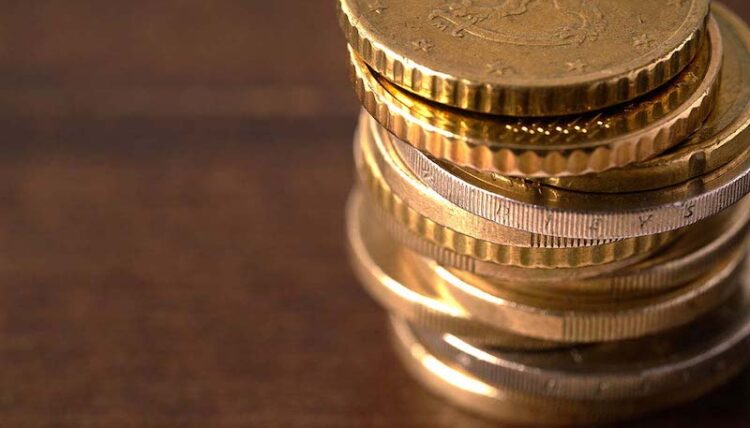
Shutterstock
How valuable is your loose change? For what it’s worth, the answer might surprise you. Currently, there are countless coins with hidden value just waiting to be discovered. Some on this list are famously harder to find than others, but a special few often hide in plain sight. It’s all a matter of knowing what to look for.
The “In God We Rust” Kansas Quarter – $100
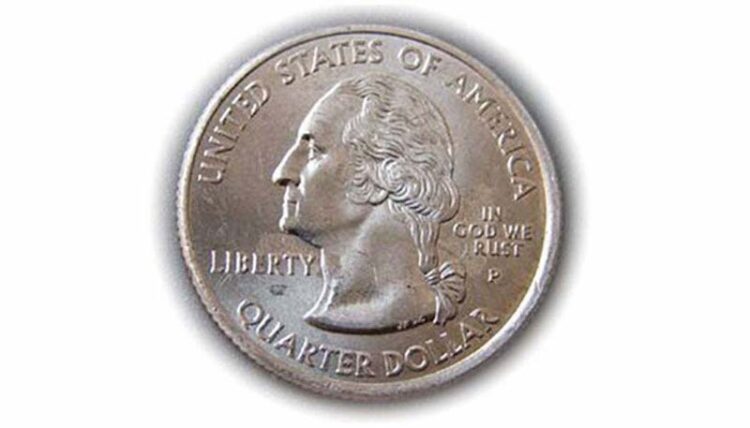
The Spruce Crafts
The Kansas quarter made its minted debut in 2005, but something was notably missing. Instead of “In God We Trust,” this collector’s coin reads, “In God We Rust” The culprit behind the funny flaw? Ironically, it was the result of too much grease at minting.
Due to what’s frequently called a “filled die” error, excess grease in the printing machine led to coins coming out with one less “t.” Currently, this one’s still in circulation. So, if you stumble upon the “In God We Rust” quarter, count your blessings. In mint condition, it could be worth up to $100 or more.
The “Godless” 2007 Presidential Dollar – $1,000
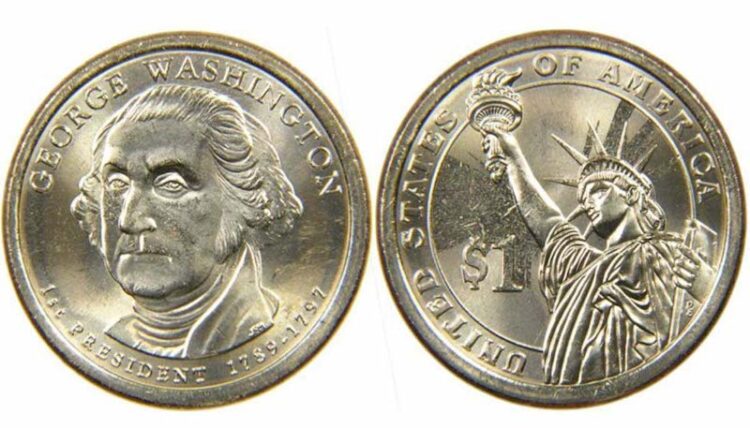
vcoins.com
Commonly called the “Godless dollar,” the phrase “In God We Trust” is completely missing from this error coin. Thousands of flawed Presidental dollars were produced in 2007. As you might expect, the major oversight did not go unnoticed by the masses or the media.
These days, one “Godless dollar” could potentially sell for around $1,000, but most aren’t worth that much. Nevertheless, you could be in luck. On eBay, a few of these coveted coins have been priced upward of $2,000. Currently, the price for a typical “Godless dollar” ranges from $4 to $400.
The “Speared Buffalo” 2005 Nickel – $1,000
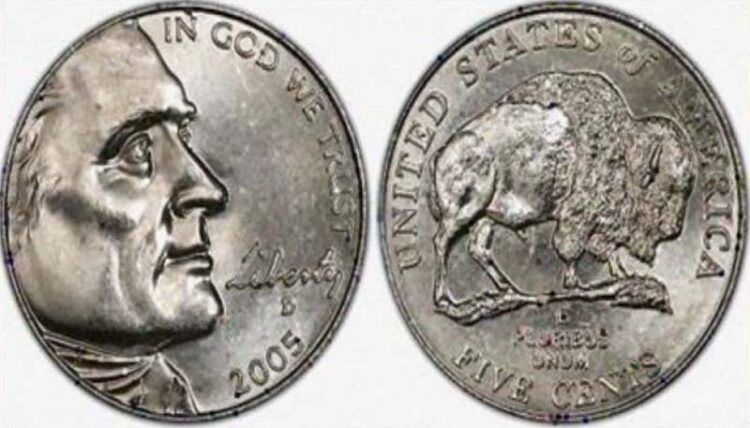
pinterest/@houseplants.liferesh.com
Believe it or not, this buffalo nickel could really put a hole in your pocket. In 2005, the Bison Jefferson design was brought back for the Westward Journey Nickel Series. However, this particular coin honoring Western exploration was minted with one glaring design error.
The “speared Buffalo” Jefferson nickel was the result of a die gouge passing through the buffalo, hence the name. In mint condition, this little nickel could rake in over $1,000. Unfortunately, the commemorative coins and their errors were not all created equally. Many are only valued between 50 and 100 dollars.
The “No Mark” P 1982 Dime – 2,000 or more
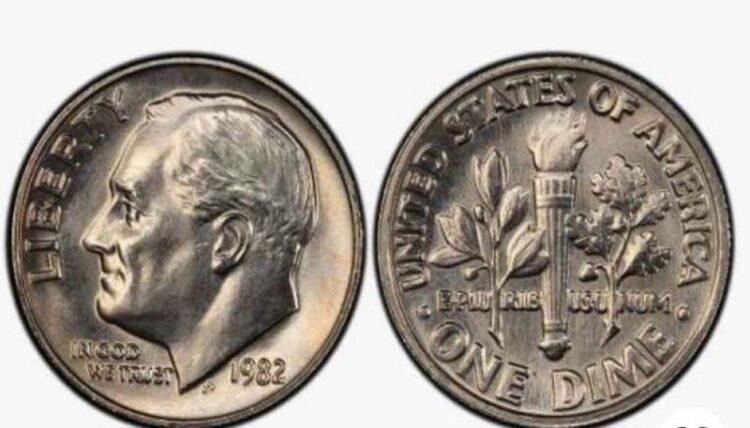
pinterest/msn.com
This “no mark” dime made its historic debut in 1982. Before its circulation, no coin of its kind had been released. In turn, it is considered both rare and valuable in many collector’s circles. To hit the jackpot with this one, you’ll want to look out for the missing “p” or “d” mintmark. Most “no mark” dimes from 1982 are worth between $250 and $300.
Many counterfeits exist, so consider yourself warned. If you do find the real deal in mint condition, it could be worth much more than meets the eye, depending on the grade. 1982 Roosevelt dimes without the “p” mintmark have sold for $1,300, $1,400, and sometimes over $2,000. If you happen upon one missing the “d” mintmark, it could be worth even more than that.
The Kennedy 1964 Silver Half Dollar – $500-$1,500
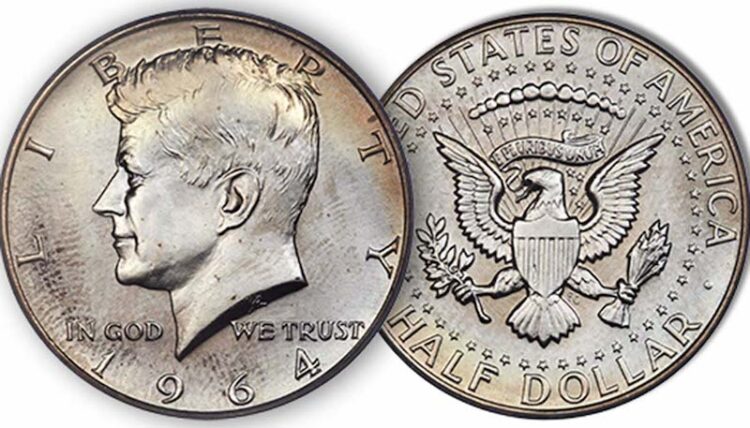
Coin Week
This briefly circulated coin is a rarity for more reasons than one. Kennedy half dollars were first minted a few months after John F. Kennedy’s assassination. Originally, they contained 90% silver and 10% copper, but 1964 turned out to be the first and last year these rare coins were minted this way.
The following batch of Kennedy half dollars, minted between 1965 and 1970, were only made with 40% silver. Eventually, they did not contain silver at all. In uncirculated condition, these mostly silver half dollars honoring JFK are potentially worth anywhere from $500 to $1500.
The Alaska Rural Rehabilitation 1935 Token – $1,750
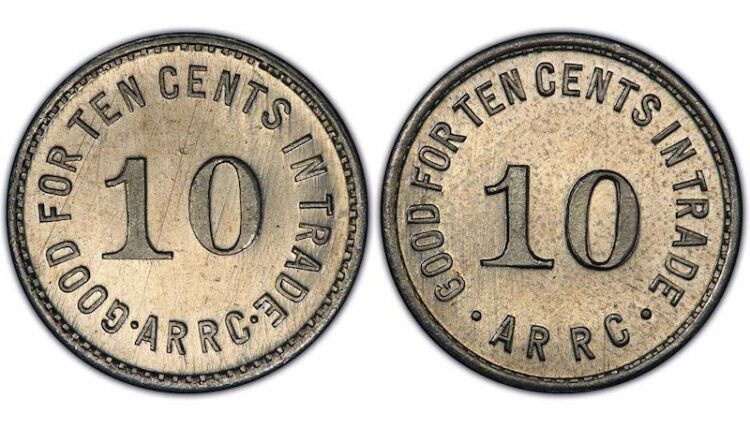
cgobr.com
When Alaskan families were relocated by the Federal Emergency Relocation Administration, they were given federal tender called “scrip ? coins, only accepted at government stores. They included denominations from 1 cent to $10 but wound up being worth much more in the end.
During 1935 and 1936, these unusual tokens remained in circulation for a six-month period. Once deemed no longer useful, most were traded for regular U.S. currency and promptly melted down. However, a few of these elusive tokens are still floating around. One of these 10 cent coins could potentially be worth up to $1,750 today.
The Sacagawea “Cheerios” 2000 Dollar – $2,746
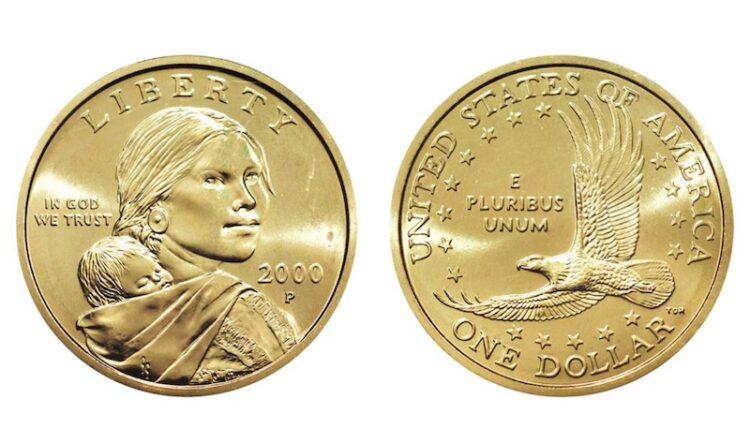
USA Coin Book
As part of a promotion, General Mills released the “Cheerios dollar” in 2000. 5,500 Sacagawea dollars were placed inside select boxes of Cheerios, but the turn of the century contest didn’t go as planned. The intended design was not ready in time for the Y2K competition and what resulted unwittingly increased the value.
For the contest, the U.S. Mint provided a somewhat different version of the coin with enhanced tail feathers of the eagle. To this day, very few have been discovered. If you come across this $1 coin in uncirculated and perfect condition, it is said to be worth $2,746. Although, some have sold for much more. “Cheerio dollars” have been snagged for $5,000 to upward of $20,000, depending on their grade.
The Wheat “No Mint Mark” 1937 Penny – $7,200
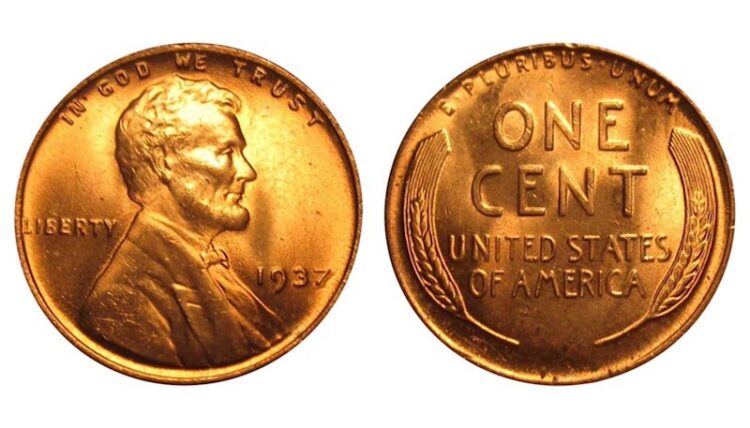
coinbook.com
Most wheat pennies are only worth about 5 cents tops, but not all “wheat cents” are as special as the 1937 “no mark” penny. Sure, some 1937 wheat pennies are valued around only 35 cents, with those in mint condition worth maybe between four and five dollars. Luckily for avid collectors, there are a few exceptions, and this error coin is one of them.
This rare wheat penny is missing the Philadelphia “P” mint marking, upping its value significantly. Some have sold for $145, $200, $500, or more. In fact, one of these prized pennies in mint condition has fetched an astonishing $7,200. Now there’s a penny for your thoughts.
The Hawaiian Plantation Token – $1,000 to 11,000
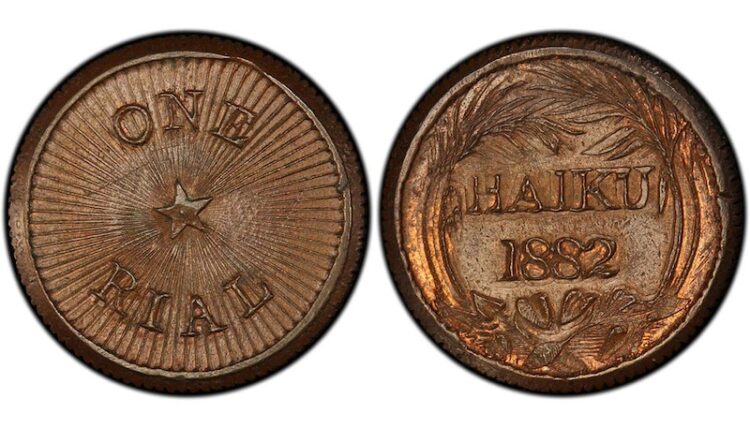
pcgs.com
In the late 1800s, Hawaii issued coinage. While the Hawaiian plantation token wasn’t considered official currency back in 1860, it was used regularly on Hawaiian sugar plantations until 1891. At the time, these unique tokens weren’t considered particularly valuable anywhere else. Nowadays, that has drastically changed.
The sought-after coin above is the Haiku plantation token of 1882. It’s often considered the most visually pleasing and “well struck” of all plantation tokens. No matter the plantation they hail from or the coin quality, these treasured tokens are quite valuable and equally difficult to track down. If you are lucky enough to claim one, you’re definitely in the money. In 2014, one sold for over $11,000.
The US Philippines 1906 Peso – $40,000 or more
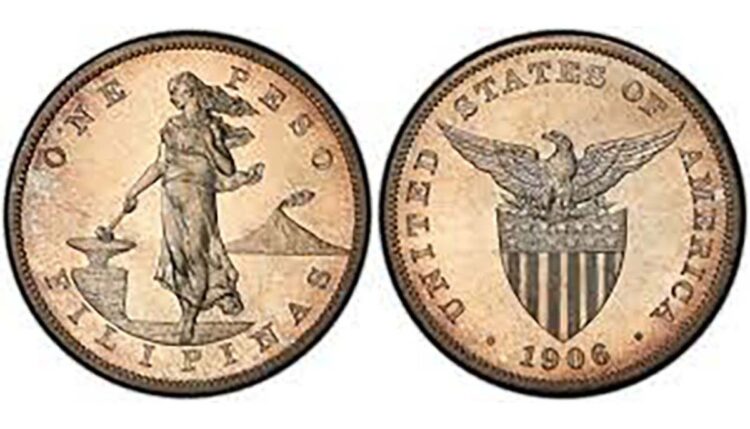
pcgs.com
This stunning and scarce coin is coveted on both sides of the Pacific. Initially, the U.S. Philippines 1906 Peso had an exchange rate of two Philippine Pesos to one U.S. dollar. Made of silver, this unique coin quickly exceeded its face value. Like so many silver coins of its time, it was melted down and almost forgotten.
Often called “the King of Philippine Pesos” today, it’s believed there are only 250 or so still in existence. Finding this dual national coin, especially in mint condition, is almost unheard of. This is probably why some of the best-preserved Philippine pesos from 1906-1908 have been valued between $20,000 and $40,000.
The Double Die 1969 Penny – $45,000 or more
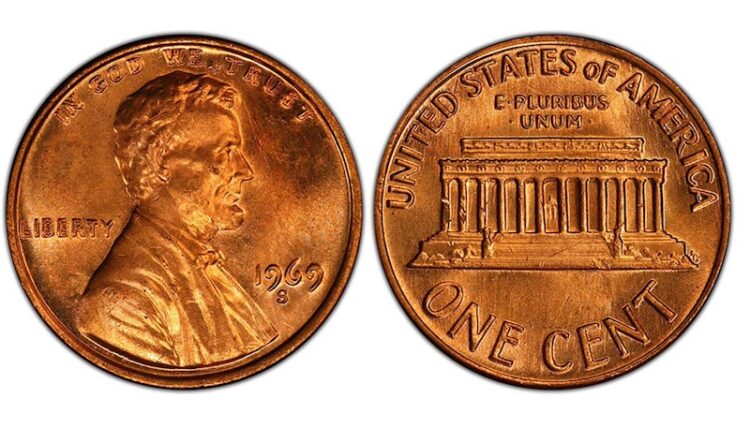
pcgs.com
If you find a penny, pick it up, and discover it to be a double-stamped “head” penny, you’re in luck. No matter when it was minted, a double die penny is one of the most valuable US coins in existence. The double die penny from 1969 is often at the top of the priceless penny list. So keep your eyes peeled for this one.
While the 1969 double die penny isn’t the only one of its kind, it does boast one of the highest price points to date. In mint condition, this valuable coin could be worth around $10,000. On top of that, the uncirculated ones can easily go for a cool $45,000. In rare cases, some are even said to be worth close to $100,000.
The Gold 1851 Mormon Coins – Up to $50,000
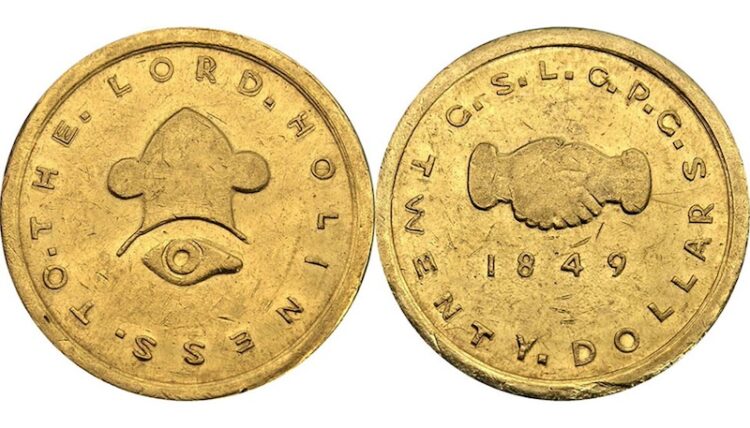
pcgs.com
Talk about a gold rush! Mormon coins were made from gold originating in California. Thanks to the timing, they carry a unique history of their own. Designed by Brigham Young himself, Mormon coins struck between 1848 and 1851 are considered extremely rare and special. These privately produced coins minted at the height of the California Gold Rush are usually worth about $20. With that said, some have notably higher values, sometimes upward of 50,000.
This $20 gold piece from 1849 is a bit unusual. It’s the first of the $20 denomination ever produced in America, beating the United States government by a year. One of these rare coins was claimed for a staggering $558,125 at an auction in 2014. Some are valued even higher than that, depending on grade. You may ask Brisbane gold coins for sale how much the price of their coins are. Unfortunately, most Mormon coins were melted down for their imminent value long ago.
The Aluminum 1974 Penny – Up to $250,000
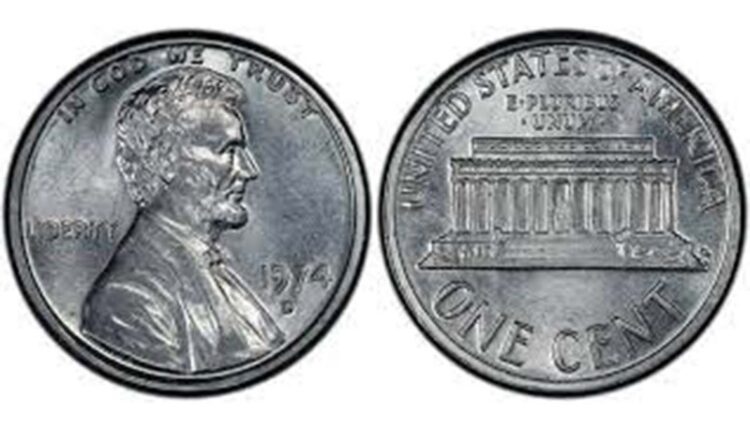
Coin Week
In the 1970s, the price of copper was steadily rising. The U.S. Mint came up with a cost-efficient solution, but it didn’t last long. Initially, the idea was to produce aluminum-stamped pennies and almost 2 million were minted. When the plan was inevitably tossed out, most of these rare coins were melted down. Very few have turned up to this day.
Reportedly, none have been sold. In turn, the chances of stumbling upon a 1974 aluminum penny remain incredibly slim. Currently, only two have been publicly claimed, with one being held onto tightly by the Smithsonian Museum. Those with an eye for truly rare coins have estimated its worth at nearly a quarter-million dollars and counting.
Morgan Silver Dollar – Up to $425,500
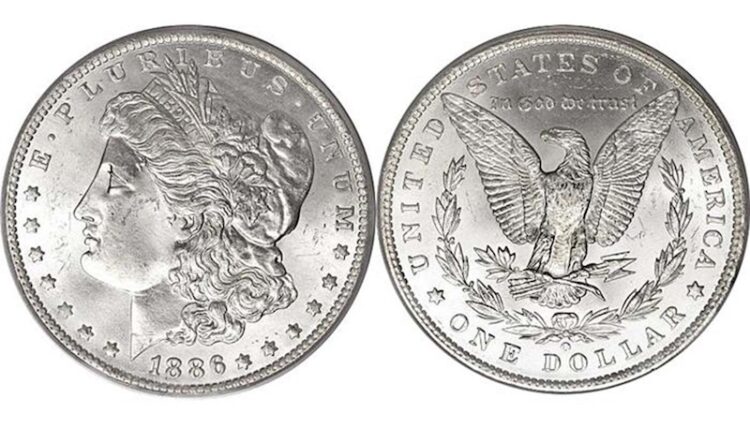
coinauctionshelp.com
From 1874 through 1904, the Morgan silver dollar was already making a name for itself. At the time, they were made with the best silver money could buy. Today, their values can be vastly different, ranging from less than $20 to over $1000. However, a special few are prizes to be won in the eyes of any seasoned collector.
Designed by George T. Morgan, these rare coins were minted with 90% silver and 10% copper. Adding to the historic significance, Morgan silver dollars were the first coins created following the demonetization of silver by Congress in the late 1800s. The most valuable of which could be yours for the jaw-dropping price of $425,500.
Walking Liberty Half Dollar – $10 – $190,000
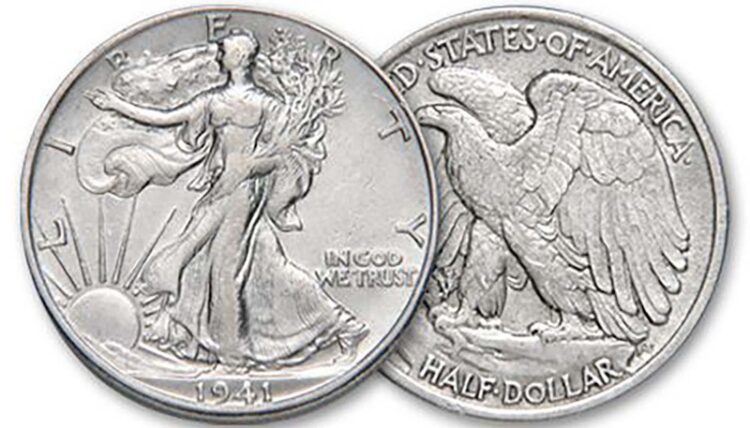
govmint.com
The Walking Liberty Half Dollar is noteworthy to many collectors’ circles. Regardless of grade, they’re always in demand. The striking coin was minted near the end of World War I and remained in circulation until 1947. These days, Walking Liberty half dollars can be as pricey as they are patriotic.
One of these hard-to-find half dollars in tiptop shape could be worth around $200,000. With that said, the value for these can vary greatly. You’ll get the most out of those uncirculated. Made of 90% silver and 10% copper, Walking Liberty half dollars in poor condition will still garner around $10.
Copper Wheat Penny – Up to $200,000
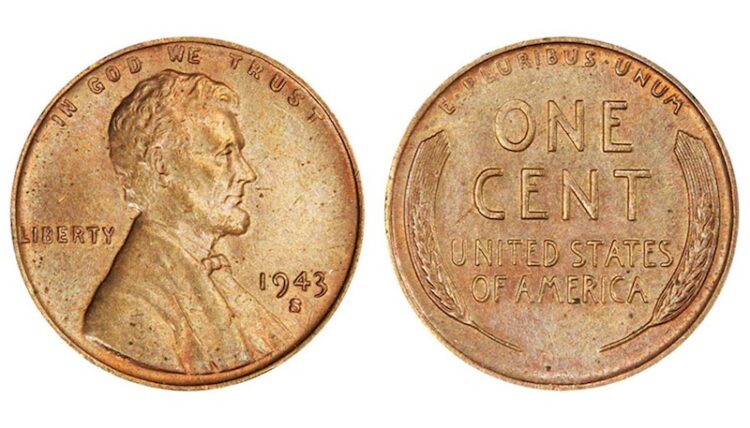
USA Coin Book
Never underestimate the value of a penny, especially not this one. In 1943, all pennies, better known as “war pennies ? were made of steel rather than copper. Or at least, they were supposed to be. Likely due to a minting mix-up, a small batch was made out of copper. The rest is coin error history.
Thus far, less than 30 of these precious pennies have been found. Adding to the intrigue, it’s believed there are only 40 on the planet. Due to this single error, the value of a 1943 copper wheat penny in mint condition can be out of this world. Those in “perfect ? condition are valued anywhere from $60,000 to $200,000. In 2019, one sold at auction for $204,000.
1894-S Barber Dime – $2 Million
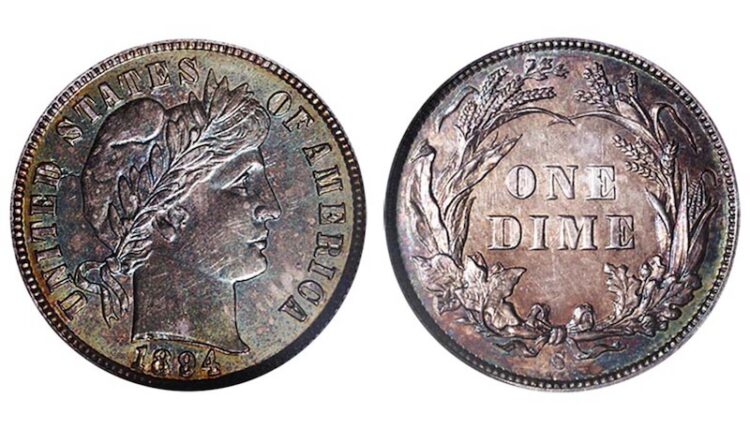
USA Coin Book
Perhaps one of the rarest coins on the list, the 1894-S Barber dime is considered highly valuable. The United States barber coinage specialness is partly due to how few have ever existed. It is believed that only 24 were minted and potentially only 9 or 10 are still out there.
With the odds of finding one so low, it’s no wonder barber dimes are often priced in the millions. In 2005, a collector secured this rare wonder for $1.3 million. The numbers go up from there, depending on grade. In 2007, another lucky bidder scored their very own barber dime for roughly $1.9 million.
Sacagawea Double Denomination Mule Error – $117,500

coinnews.com
Sometimes, a major coin error can result in a massively lucrative payout for coin collectors. Case in point: the 2000 Sacagawea dollar with the double denomination mule error. At face value, it could seem like an ordinary coin. But when you flip it over, you’re in for a surprise.
The Sacagawea double denomination mule error dollar is basically two coins in one. On the front, there’s the classic George Washington design where Sacagawea was meant to be. The reverse of this flawed coin, however, depicts the intended eagle design. Currently, only 16 of these mule error coins are said to be up for grabs. If you’re lucky enough to own one, they’re incredibly valuable. One sold at an auction for $117,500.
The 1804 Bowed Liberty Dollar – $3 Million or More
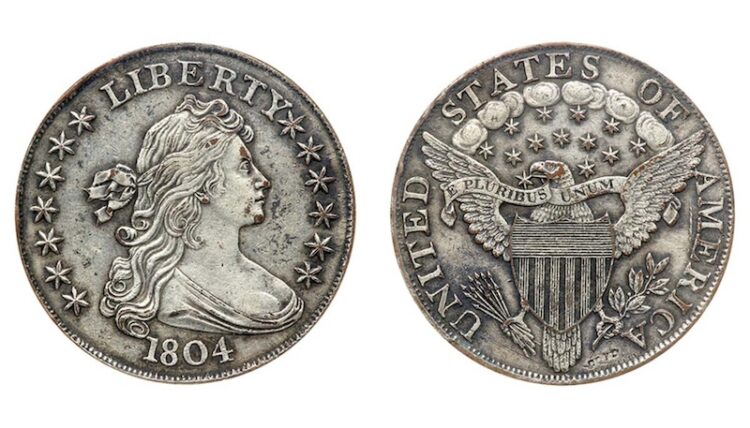
USA Coin Book
If you encounter one of these rarities, you might want to hold onto it. The Bowed Liberty Dollar is said to be worth millions, assuming you’re looking at the real thing. Often known among collectors as “the king of American coins, ? only 15 are believed to exist. Unsurprisingly, their true value and scarcity have made them a popular coin for counterfeiters to reproduce.
This one-of-a-kind coin is stamped “1804,” but none were made that year. All liberty dollars were minted in the 1830s or beyond. Their average value is estimated between $10,000 to $20,000. With that said, serious collectors have been willing to pay even bigger bucks for those in minted condition. During the late 1990s, one impressive specimen sold for over $4 million.
Liberty Head Nickel – Up to $4.5 Million
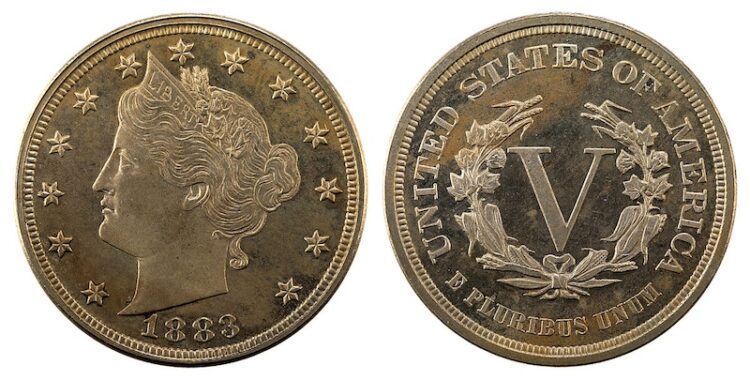
USA Gold Bureau
Take a look at the 1913 Liberty Head nickel. Popularly called a “v-nickel, ? this uncommon coin is revered as one of the most valuable out there. Assuming it can be found, of course. The Liberty Head nickel of 1913 frequently tops the list of rarest nickels on the planet. First produced in 1883, the five-cent pieces currently accounted for are dated 1913. Never released into circulation, it is estimated that only five of these were ever minted.
While worth millions today, the origin of the Liberty Head nickel remains a bit of a mystery. Although, it is widely believed they were minted in Philadelphia, which makes total sense. In 2018, one of these topnotch nickels sold for a whopping $4,560,000. The “best-preserved” of the five is valued somewhere around $5 million or more.
Flowing Hair Dollar – $2,500
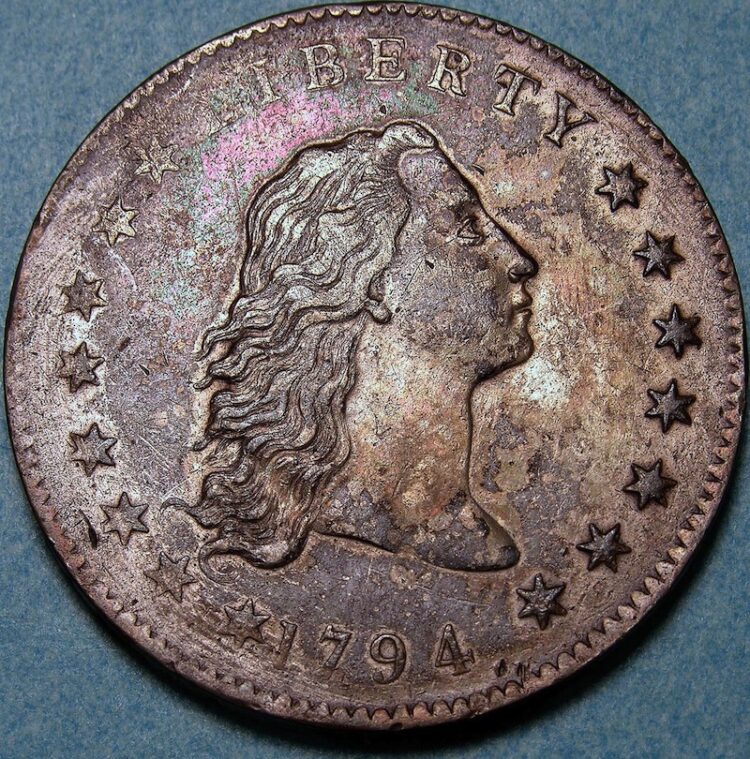
Wikipedia
The Flowing Hair Dollar is the inaugural silver dollar coin issued by the United States Mint in 1794 and 1795. Designed by Chief Engraver Robert Scot, it features a bust of Liberty with flowing hair on the obverse and an eagle perched on a rock surrounded by a wreath on the reverse.
Comprising 90% silver and 10% copper, the coin weighs approximately 26.96 grams. With low mintages—1,758 in 1794 and 160,295 in 1795—the Flowing Hair Dollar is a rare and historically significant coin, representing the early days of American coinage.
1879 $4 Gold Stella – Up to $5,000
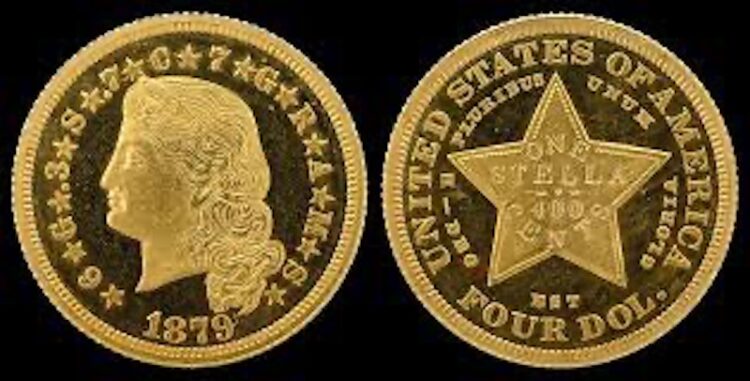
Wikipedia
The 1879 $4 Gold Stella is a unique and rare coin produced by the United States Mint as part of a proposed international coinage system. Designed by Charles E. Barber, the coin features a flowing hair Liberty on the obverse and a depiction of a coiled hair eagle on the reverse. The denomination, four dollars, is expressed in Roman numerals as “IV.”
While the Stella was never circulated widely and was primarily intended for presentation purposes, it has become highly sought after by collectors due to its historical significance and distinctive design.
1927-D Saint-Gaudens Double Eagle – up to $3 million
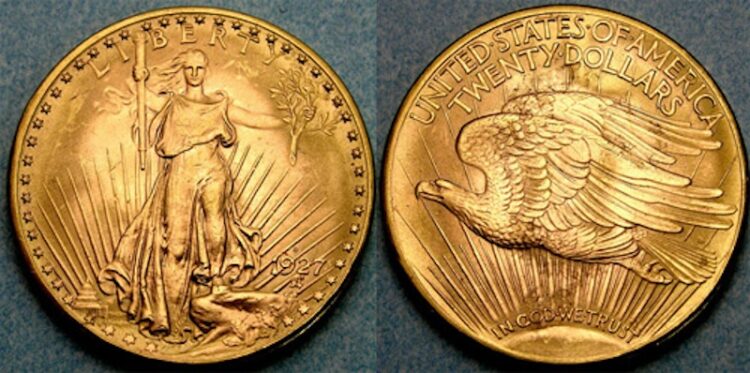
Saint Gaudens Double Eagle
The Saint-Gaudens Double Eagle is a significant and visually striking gold coin produced by the United States Mint from 1907 to 1933. Designed by renowned sculptor Augustus Saint-Gaudens, the coin features a majestic depiction of Liberty on the obverse, holding a torch and an olive branch with the Capitol building in the background.
The reverse showcases an eagle in flight. This coin, with a face value of $20, was commissioned by President Theodore Roosevelt to enhance the artistic appeal of American coinage. The Saint-Gaudens Double Eagle is widely regarded as one of the most beautiful coins in U.S. history.
1916 Standing Liberty Quarter – up to $2,800
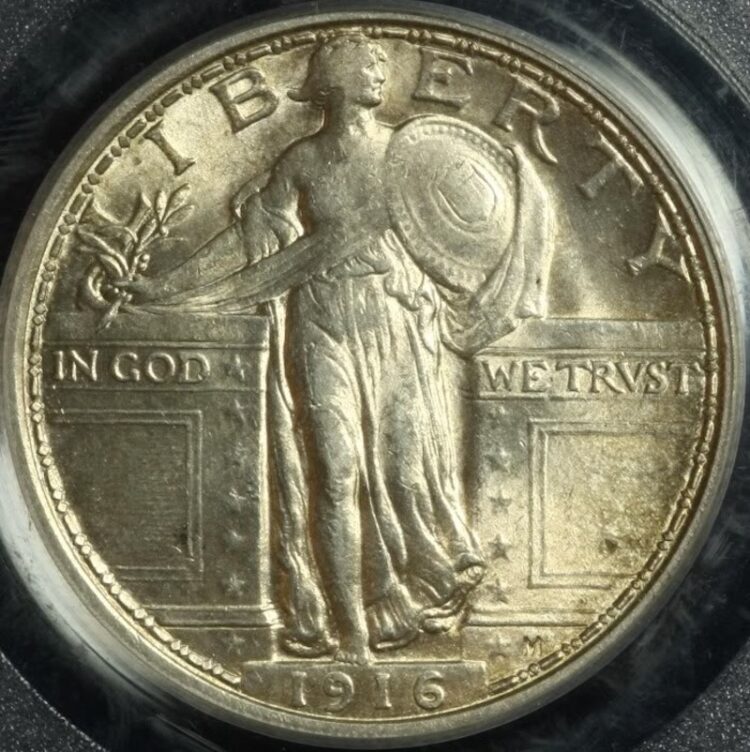
Wikipedia
The 1916 Standing Liberty Quarter is a notable numismatic piece that marked a departure from the previously used design. Designed by Hermon A. MacNeil, the coin features Lady Liberty standing in a dynamic pose with a raised shield and an olive branch, symbolizing both strength and peace.
The initial version lacked protective chain mail, exposing Liberty’s right breast, which generated controversy and led to a modified design later that year. This modification included adding chain mail to address concerns about modesty.
1921 Peace Dollar – up to $125
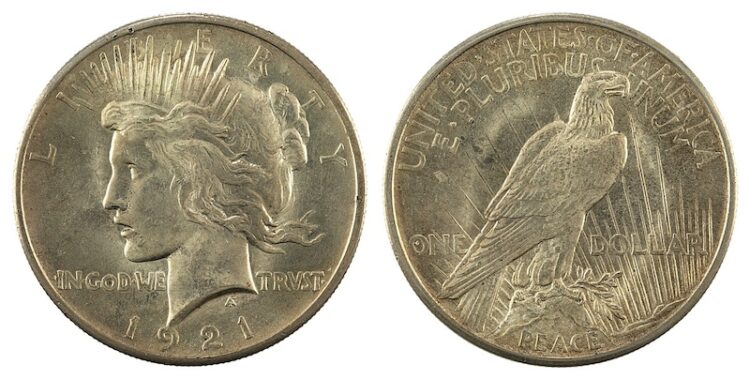
Wikipedia
The 1921 Peace Dollar is a pivotal coin in American numismatics, representing a brief departure from the Morgan Dollar design. Designed by Anthony de Francisci, it was minted to commemorate the end of World War I and promote peace. The obverse features a left-facing profile of Liberty with a radiant crown, while the reverse displays a perched eagle with an olive branch, symbolizing peace.
Struck in high relief, the initial version faced production challenges and was subsequently modified for mass production. The Peace Dollar series continued until 1935, leaving a lasting legacy.
Brasher Doubloon – up to $9 million
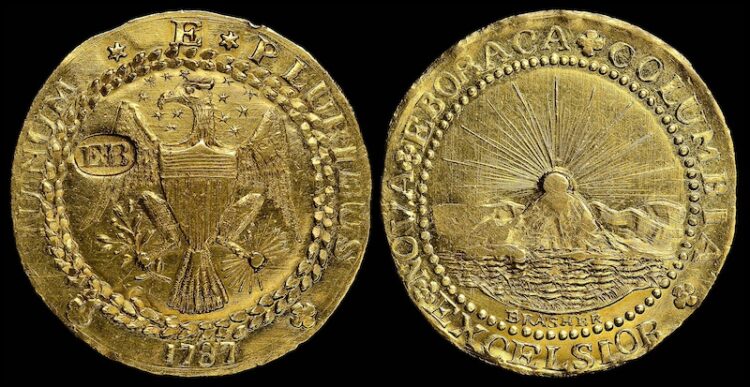
Wikipedia
The Brasher Doubloon is an iconic and rare American gold coin, created by silversmith and goldsmith Ephraim Brasher in 1787. This historical coin, considered one of the first gold coins struck in the United States, features a distinctive design with a heraldic eagle on the obverse and a sun over mountains on the reverse.
Brasher, who was also a neighbor of George Washington, stamped his unique hallmark on the eagle’s breast, consisting of his initials “EB” and a small punch that resembled a cornstalk. Only a small number of Brasher Doubloons are known to exist, making them highly coveted by collectors.
3-legged Buffalo Nickel – Up to $100,000
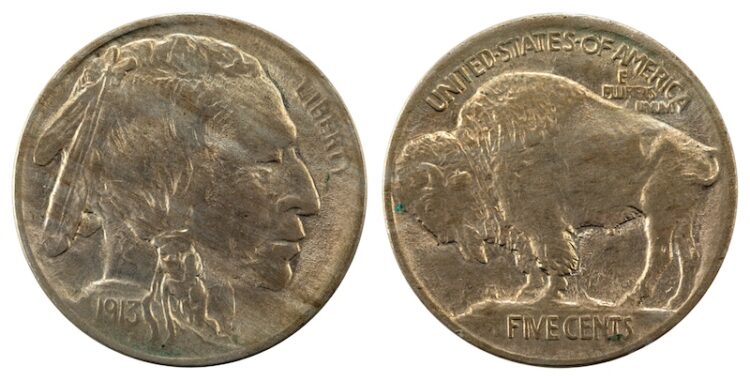
Wikipedia
The 3-Legged Buffalo Nickel refers to a rare and sought-after variety of the Buffalo Nickel, a five-cent coin minted by the United States from 1913 to 1938. The variety is characterized by a noticeably absent foreleg on the buffalo on the reverse side of the coin. This error occurred when a Mint employee attempted to repair a damaged die by polishing away the raised details, inadvertently removing one of the buffalo’s legs in the process.
The error was quickly corrected, resulting in a limited number of 3-Legged Buffalo Nickels entering circulation. Collectors prize these coins for their uniqueness and rarity.
Flying Eagle Cent – Up to $172,500
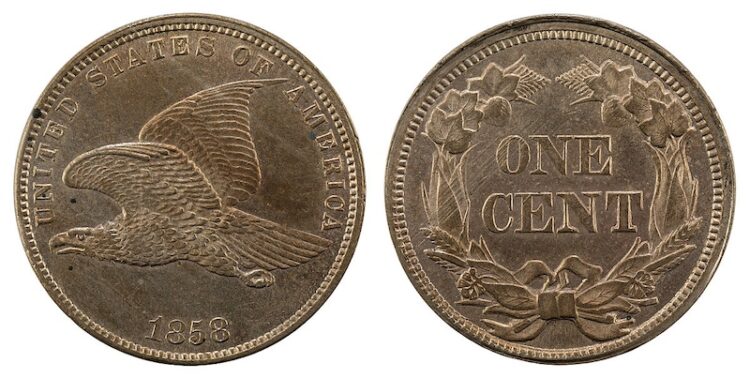
Wikipedia
The Flying Eagle Cent holds historical significance as one of the early designs of the one-cent coin in the United States. Introduced in 1856, it replaced the larger and heavier Large Cent. The coin features a stylized representation of an eagle in flight on the obverse, giving rise to its name.
Designed by James B. Longacre, the Flying Eagle Cent was initially minted in limited quantities for circulation and was composed of copper-nickel. Its smaller size and lower production costs made it more practical than its predecessor.
1871-CC Seated Liberty Dime – Up to $270,250
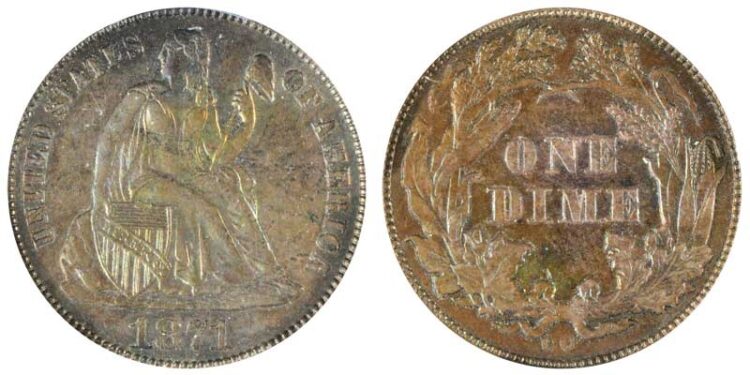
USA Coin Book
The 1871-CC Seated Liberty Dime is a numismatic rarity and a product of the Carson City Mint. Carson City, Nevada, was known for minting coins during the 19th century, and the Seated Liberty Dime from 1871 is particularly noteworthy. The Seated Liberty Dime features Lady Liberty seated on a rock, holding a shield with a liberty pole.
The “CC” mintmark on the reverse indicates its origin. The 1871-CC is scarce, with a low mintage, partly due to the economic challenges of the time. Surviving examples are highly sought after by collectors, and their rarity contributes to their value.
Capped Bust Half Dollar – Up to $763,750
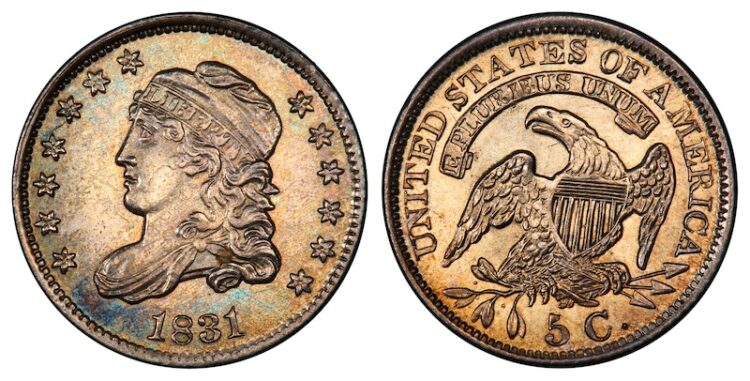
Wikipedia
The Capped Bust Half Dollar is a historic coin series that was minted by the United States from 1807 to 1839. Designed by John Reich, the obverse of the coin features Lady Liberty with a Phrygian cap, facing left, while the reverse depicts a bald eagle with a shield on its chest.
The design went through several modifications during its production period, resulting in different varieties such as the Lettered Edge and Reeded Edge types. The Capped Bust Half Dollar is characterized by a distinctive portrait of Liberty with her hair in a cap, giving the series its name.

Comments
Loading…